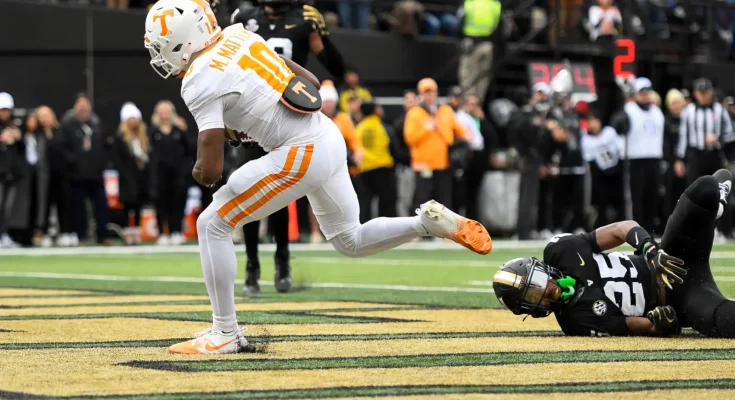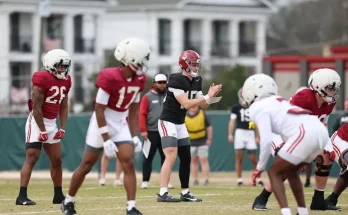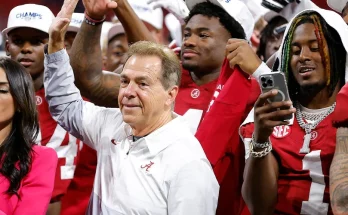Mike Matthews’ injury raises more wide receiver problems for Tennessee football.
Tennessee entered fall camp hoping to reset expectations at wide receiver, handing responsibility to a young and largely untested group. With Mike Matthews, the former five‑star recruit, positioned to emerge into a featured role after a modest freshman season of seven catches for 90 yards and two touchdowns, expectations were clear: he needed to be the centerpiece of a receivers corps in transition. Instead, a new injury during practice has surfaced just as Matthews appeared poised to take the next step casting fresh uncertainty on a depth chart already fraught with personnel losses and inexperience.
Matthews has battled through recurring minor injuries since last summer, but head coach Josh Heupel emphasized earlier this year that while he struggled physically at times in 2024, Matthews “is as healthy as he’s been right now in a long time” during spring workouts. That optimism made it easier to envision a sophomore breakout season where Tennessee leaned into his in‑state pedigree and raw talent to anchor the passing game. But the new setback this week Matthews was seen stretching on the side of practice and did not fully participate in drills signals something more than normal wear‑and‑tear. Though described by local reporters as non‑long‑term, the timing couldn’t be worse: Tennessee now fields only five healthy scholarship receivers in camp, and among those Chris Brazzell is also dealing with an undisclosed injury.
That left Tennessee’s quarterback competition—between Joey Aguilar and Jake Merklinger—with even fewer weapons at its disposal. Aguilar began as the presumed starter based on experience, but without reliable targets, questions mount about his ability to lead a vertically challenged offense. Merklinger, who has remained with the Vols throughout his tenure, faces a similar uphill battle; without depth or proven options at receiver, neither signal‑caller can execute a modern passing attack.
The core issue stretches beyond Matthews’ current status. Tennessee lost three of its top four wideouts from the 2024 roster via transfer portal departures and NFL draft exits. That mass exodus left an unexpected void. Despite keeping modest portal activity, Tennessee wasn’t replenished adequately from the outside. Instead, the Vols turned inward: relying on true freshmen Braylon Staley and rookies like Squirrel White, along with Chris Brazzell II, a redshirt junior who hauled in 29 catches for 333 yards in 2024, as well as tight end Miles Kitselman potentially leading the team in receiving.
That’s the backdrop to why Matthews’ injury matters so much. If he misses time or returns limited Matthews may never reach the point of consistency Tennessee hoped for. In his freshman year, hampered by a hamstring injury in camp, he flashed explosiveness, got behind the defense in big moments, but never gained momentum. The result was situational usage, limited targets, and occasional frustration Matthews even entered the transfer portal last December before deciding to stay in Knoxville. Coaches called that decision a reset an acceptance of process—but they always cautioned Matthews would need to stay healthy and earn more trust this year.
Adding insult to injury, talk in fan communities and message boards grew salty in January. One commentator questioned whether Tennessee’s staff had mismanaged Matthews in practices suggesting if he couldn’t earn more reps earlier despite both injuries and poor competition, maybe the staff evaluation process faltered. Others touted Cincinnati and Georgia as potential landing spots; didn’t anything click during camp or film review to make him stick? That skepticism is now echoed by concerns over depth: if Matthews is unavailable at kickoff of fall camp, will Tennessee truly be able to situate him as a featured target for the season opener against Syracuse on August 30?
The injury compounds concerns for a room that already barely fits within scholarship limits. With Matthews and Brazzell sidelined, Tennessee has exactly five healthy scholarship receivers Brazzell, Dont’e Thornton, Bru McCoy, Squirrel White, and Braylon Staley. Thornton and McCoy both battled through injuries in 2024 too; White is a true freshman; Staley is a former four-star recruit yet with only minimal playing time. With such little margin for mishap, any further setback could force Tennessee into heavy use of tight ends and trickle‑in packages to compensate.
Heupel acknowledged publicly that the portal timing hit the Vols unusually hard—some transfers entered in the postseason window and were simply ineligible to play in bowl games. That cut into experienced depth at exactly the wrong moment, meaning returning sophomores like Matthews carry weight far beyond what their limited game tape might justify. The younger players are stable for the future—but not yet consistent enough to lead the 2025 passing game.
In spring practice, Tennessee’s staff highlighted maturity and focus gains from Matthews. He stood out physically adding muscle, improving control and mental reps. The coaching staff heralded his opportunities as significant: “he’ll go from depth piece to one of the featured offensive players,” per SI coverage. But that projection depended entirely on availability. Now, with the fresh injury, the leap may be delayed or derailed. Early fall camp was supposed to show Matthews growing his role; instead, he may lose snaps or targets to emerging freshmen, and possibly lose timing with the quarterback.
Meanwhile Tennessee’s broader wide‑receiver preview by the SEC media ranks the Vols’ room as near the bottom of the conference No. 12 due to lack of star power and transfers. That’s a brutal ranking for a storied program, reinforcing how fragile and unsettled Tennessee’s receiver depth is. Analyses flagged tight ends like Kitselman as potential leading receivers not a reflection of optimism but necessity. It also highlighted Brazzell’s 6‑5 frame as safe pick to lead the room, but questioned whether he can consistently outrun SEC secondaries.
All of this situates Johnson higher stakes on Matthews’ recovery timeline. The Vols’ coach reiterated that Matthews “is as healthy as he’s been in a long time,” referencing pre‑season camp. But then this injury emerged just before formal scrimmages, shifting health status from headline to question mark. Tennessee still has weeks before kickoff but every practice without him delays timing work; every limitation in training diminishes opportunities to crescendo into form.
If Matthews remains sidelined into August, Tennessee may be forced into heavy use of packages built around tight ends and incorporating run‑first sets. Without receiving depth, opposing defenses can load the box and dare Tennessee to win in space with unproven options. That undermines continuity between quarterback and receivers and reduces flexibility in play‑calling. As Ohio State and Florida enter the schedule early, Tennessee’s offensive playmakers may be too thin to compete.
For Matthews personally, this becomes a test of resilience. As a five‑star recruit, his freshman season featured both excitement and frustration. He had the ability to go deep, out‑jump defenders and shock defenses but consistency eluded him. Coaches lauded his work ethic; analysts noted he had film worthy of other elite recruits. But after entering the portal, leaving, then returning, the pressure to perform in Year 2 intensified. Now the injury risk undermines progress not physically devastating, but enough to alter momentum and confidence.
Despite the concerns, Tennessee isn’t without hope. Heupel emphasized meetings, personal growth, mental discipline and maturity traits Matthews has shown since spring. If he returns to full health before camp’s peak, he may still emerge into the projected role. Redshirt freshman Braylon Staley also looks promising; if Matthews and Brazzell recover early, the inexperienced parts of the room still may flourish behind them. But reconstructing continuity mid‑camp is tricky; timing between receiver and quarterback perks into high‑risk territory.
Ultimately, Tennessee’s wide receiver room remains riddled with question marks many of which were already in plain sight. Mike Matthews was supposed to be the exponential upside in Year 2; his injury stings not just because he may miss practice, but because his absence now jeopardizes momentum, development, and Tennessee’s chance to build inside chemistry. The threshold for error is too low in 2025. Coach Heupel needs Matthews on the field, healthy, and growing trust fast or Tennessee’s passing game could experience a sophomore slide rather than zone‑stretching growth.



